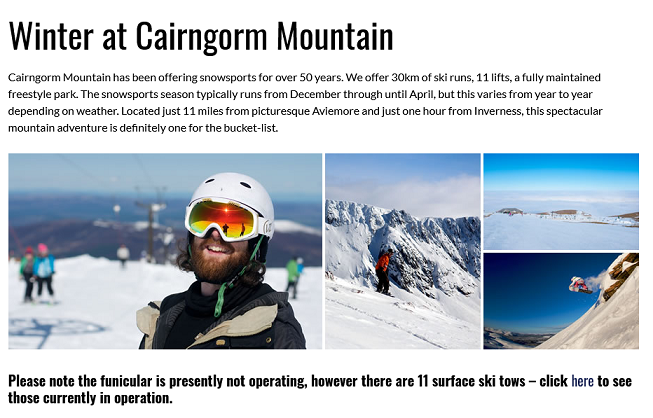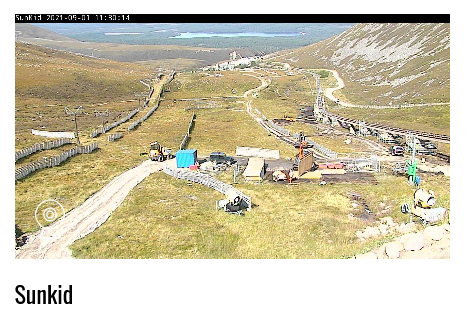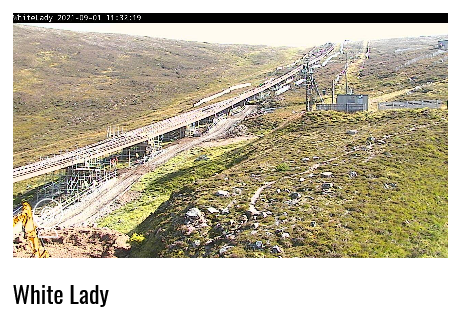On 25th August Highlands and Islands Enterprise (HIE) announced (see here) that the re-opening of the funicular had been postponed until Autumn of 2022. Their news release was widely copied and pasted by various media outlets with little critical comment (with a few honourable exceptions, e.g (see here)). This post compares HIE’s latest claims about the funicular repairs with the facts, including what they have said in the past
Claims v facts
HIE’s claim: “The current phase of engineering works to strengthen the 1.9km viaduct that supports the railway track began in April 2021, with the aim of returning the funicular to service early next year” [i.e 2022].
The facts. Back in November 2020 HIE had issued a news release (see here) claiming work had started on the funicular repair which made no mention of “phases”: “The plan is to keep working for as long as possible during what remains of 2020, then resume as early as we can in the new year. That way, we can continue to keep the project on track to resume the service as planned in winter 2021/22.”
The Full Business Case published by HIE in November 2020 (see here) included this timeline: “December 2021 Stage 2 Safety case sign off from DfT and funicular returns to revenue operations.” So HIE’s original aim was that the funicular should return to service this year.
HIE’s claim: “The mountain resort will stay open throughout winter, with skiers and snowboarders able to access the slopes using nine ski tows that will run every day when weather conditions are suitable”.
The facts: Actually ten surface ski tows survive at Cairngorm although Cairn Gorm Mountain claims there are eleven by double counting the funicular………………….

……..but the claim that snowsports enthusiasts will be able to access the ski tows when the “weather is suitable” is highly misleading. What is important is not the weather but snow cover. The fact is that HIE’s failure to replace the chairlifts at Cairn Gorm means it is now often impossible to access the Ptarmigan bowl, which has the most reliable snow, without a long walk and Cairngorm Mountain is unlikely to operate them in such conditions.
HIE’s claim: “According to the development agency, [the wording suggests that HIE paid some other body to write the news release] several factors have combined to lengthen the funicular reinstatement programme. These include technical challenges associated with designing and implementing effective solutions to an existing structure, as opposed to a new build.”
Comment: this statement implies that technical challenges have arisen since the repair work started last November. That means that the “Full Business Case” the HIE Board put to the Scottish Government was based on incomplete information, as HIE did not fully understand what was required, and it was therefore fundamentally flawed. If correct, that would help to confirm that Graham Garfoot was right to raise concerns about whether the repairs to funicular would work in a series of posts (see here). It also suggests that, even if the issues are now being addressed, heads should roll.
HIE’s claim. In addition, progress has been hampered by COVID impacts and by extreme weather, particularly blizzard conditions in the spring. Extra effort has also been required to source vital construction materials that are currently in short supply across the UK.
Comment. Even if it is accepted that the weather was extreme in the Spring, that does not explain a nine month extension to the timescale and nor do the Covid restrictions, which had been lifted by the time the main work was planned to be underway. HIE appears to have snatched at any excuse to cover up the design flaws in its original proposals.
HIE’s claim: “HIE interim chief executive Carroll Buxton said this combination of challenges had made rescheduling the works inevitable”.
Comment: back in December 2020 Carroll Buxton, then Deputy Chief Executive, was in attendance at HIE’s Risk and Audit Committee the minutes of which (see here) stated that “Funicular reinstatement works had started well and strong project management arrangements were in place”. So strong that in nine months the timescale for the repairs has been extended by nine months.
HIE’s claim: “Cairngorm Mountain Estate is a great visitor attraction that plays an important role in the local economy,” she [Carroll Buxton] said.

Comment. Actually, Cairn Gorm mountain is now an unattractive building site and will now apparently remain so for another year. The construction works by the Sunkid Rope tow (above), designed for beginners, probably explains why the news release stated that only nine tows will operate this winter. The beginners area appears likely to be out of action. The bigger picture is that the longer the funicular is out of action, the clearer it becomes that it is not an asset but a burden that is predicted to consume extraordinary amounts of subsidy (£73.09m over the next 30 years (see here)). New chairlifts could have been installed and up and running by now for a fraction of the costs.
HIE’s claim. “We’ve always been upfront in describing the reinstatement programme as one of the most complex and difficult civil engineering projects in Scotland.“
Comment. The truth is that HIE have NEVER explained the cause of the problems with the funicular and have been very slow to release documents relating to either the repairs or its plans (the COWI report was eventually made public in December 2020 (see here). In fact,in the Full Business Case agreed by the HIE Board, the risk assessment said nothing about the civil engineering challenges (it did mention the weather and Covid):
“When option exposure to risk is assessed, Option 1a (the ‘do minimum’ option) produces the lowest risk score and is therefore ranked highest in this element of the assessment, however, it ranks lowest in both the quantitative and qualitative analysis. Option 3b and Option 3a [ie to repair the funicular – Option 2a and 2b considered alternative new uplift] are ranked 2nd and 3rd in the risk assessment, respectively. Option 3a has a slightly higher risk score than Option 3b due to increased capital costs / associated capital funding requirements and slightly more complexity associated with project delivery / contract management. The above highlights that Options 3a and 3b are the best performing options in the quantitative and qualitative assessment and that they have a lower risk profile than all options, except for the ‘do minimum’ option.
This assessment presented to the HIE Board is totally wrong. The civil engineering risks of repairing 63 of the funicular’s 94 piers were far greater than removing it and replacing it with a modern chairlift supported by a handful of lift towers.
HIE’s summary of the position: “We’re now working with our designers and contractors on a revised schedule for the remainder of the project,” Ms Buxton added. “Harsh mountain conditions mean that all work will need to halt over winter and resume next spring. To ensure safety, there also needs to be a period of testing and certification at the end of the programme, so our current expectation is that the funicular can be relaunched in autumn 2022″.
Comment. An expectation, not a guarantee. It’s time HIE came clear about what is really going on but no doubt the public will have to rely on activitists submitting endless Freedom of Information requests to establish what has really happened.
The financial implications of the delay
The news release acknowledges the delay will have financial consequences but does not say how much:
“Clearly, a longer timescale will also have a financial impact. We’ll be reviewing costs very carefully and will publicly confirm a revised budget as soon as it’s possible to do so.”
It is not just the costs of repairs that are likely to increase, the delay will effectively mean that Cairn Gorm mountain will have almost no income for a further year. With Cairngorm Mountain’s most recent accounts (see here) showing they received almost £2 million in subsidy from the UK Government (as furlough) and HIE for the year to 31st March, another £3m is likely to be required to keep the company going until the funicular re-opens.
Whether HIE will review the number of staff employed at Cairn Gorm – 53 on average in the last accounts – is unclear. Instead of sitting at Cairn Gorm with nothing to do, with a bit of imagination those staff could be redeployed to help the National Park and reduce the impact of visitors to the Glenmore area, for example by running a minibus service to enable people to leave their cars or litter picking.
Although not clearly stated in the news release, one consequence of the increased costs is that other planning investment at Cairn Gorm has been reduced:
“Confirming its commitment to the mountain resort, HIE has also approved up to £780,000 for an extensive refurbishment of the Ptarmigan building that sits on the plateau and includes the UK’s highest restaurant, a shop, exhibition space and viewing platforms. Following competitive tender, resort operator Cairngorm Mountain (Scotland) Ltd (CMSL) has awarded a contract for the first phase of the Ptarmigan works to Simpson Builders Ltd, based in Beauly. The refurbishment is due to start at the end of August and be completed by the end of 2021.”
HIE’s original intention was to redevelop the Ptarmigan (see here) at a cost of £2.5 million. The proposed investment is now just a third of that and represents another U-turn by HIE which argued that a major redevelopment of the Ptarmigan was needed to attract people to use the funicular. If that was correct, it’s likely that the deficit in revenue at Cairngorm Mountain over the next 30 years may be even greater than the £73.09m forecast so far. (Incidentally, I have checked on the Scotland Contracts portal (see here) and I can find no mention of any tender for the Ptarmigan. Just how other potential contractors could find out about this tender is therefore unclear).
All these raises yet further questions about Audit Scotland’s role at Cairn Gorm. Audit Scotland sits on HIE’s Risk and Assurance Committee (see here for most recent published minute) and are therefore party to the failure to take a proper look at the civil engineering risks involved in repairing the funicular and the ever increasing costs. There is no excuse for this having recommended in their report on the management of Cairngorm and the funicular railway last year (see here) that HIE should:
“consider carefully the long-term sustainability and affordability of potential operating models and identify what financial support it will need to provide and how that cost will be met. It should consider this alongside its wider spending priorities”
The delay in the funicular repairs shows that neither HIE nor Audit Scotland properly considered what financial support would be required if the funicular was repaired.
The environmental and planning implications of the delay

The news release says nothing about the planning or environmental implications of the delay or what will be done to mitigate these. Will any of the holes excavated for the new props to the piers be left open over winter, to fill in with water? Will piles of spoil be left in situ waiting to be washed away in winter storms? Will the new temporary roads be left in place, with all the impact that will have on ground vegetation? How does all of this fit with the planning conditions which were supposed to minimise environmental impacts?
What needs to happen
The escalating costs of the funicular repair and the knock on consequences – together with Audit Scotland’s complicity – strengthens the case for an independent inquiry by the Scottish Parliament into how Cairn Gorm is being mismanaged.
Meanwhile, the Cairngorm National Park Authority should not just sit by and allow the building site to remain in situ over winter. The CNPA Board should now require HIE to produce plans for how they intend to protect the natural environment at Cairn Gorm this winter while construction work is suspended – whatever the financial cost. With the Met Office forecasting storms after this week – a consequence of the hurricanes in the USA – they may need to act fast.
An excellent critique of HIE’s attempt at a cover up of their incompetence with the development of their so-called business case to repair the funicular and the management of the repair process. I particularly appreciate your comments on Audit Scotland which as a supposedly independent audit organisation should have had the ability to pick up the blatantly obvious flaws with the Business Case.
Then we have the public bodies and organisations which were part of the Funicular Response Group. Where have their voices been throughout this debacle. Of course it is obvious that HIE formed the FRG just to try and control and quieten these organisations. Frankly that has been one of the few ‘successes’ HIE has had, the only other one I can think of is how they conned the Scottish Government into supporting this failure with so much taxpayers’ money. I’m not aware whether the FRG has met since late 2020, but again there has been no announcement that I can find on the FRG disbanding.
Lastly, CNPA has been totally invisible and as usual has failed in their lack of management of the planning permission conditions and scope.
This shows the comprehensive failure of all the public bodies and organisations involved. The problem is the haemorrhaging of millions of pounds of taxpayers money will continue for many years to come – until our Scottish Government wakens up to the disastrous (but avoidable) waste of public money the funicular has been. It’s interesting that none of these other public bodies and organisations involved have had the courage to speak out about the issues or even engage in the debate on the future of the failed funicular.
To be fair and accurate, it is possible to reach the Ptarmigan bowl in winter for Snowsports via the M1 lift, although this does sufficient snow cover for the length of theM1 ski tow. I noticed last winter that CAIRNGORM MOUNTAIN had also purchased a passenger cabin for the back of one of their pisten bullly tracked vehicles, presumably to assist with uplift of beginners (& non snowsports staff) to the Ptarmigan area.
I have been talking to a peat restoration officer from another area and asked him to have a look at Cairn Gorm and it’s webcams and posts on PW and if he would care to comment. His reply was “I have had a quick scan through and it is appalling what they are getting away with. I can only assume that no ECOW ( ecological clerk of works) was appointed, if there is one they are certainly not doing their job”! He also said that he would have a more indepth look at the situation and let me have full comments. That should make for some very interesting reading and possibly another PW post. While people have commented and asked what the CNPA is doing to try and control the destruction, in my opinion either the board of the CNPA has told its employees to stay away from the works on Cairn Gorm, or, more likely the CNPA has been leant on by???? Corporate bullying!
I went up the Cairnwell Chairlift a couple of weeks ago for a lazy day on the hill.
Its the simple access solution that they should have put in place on Cairngorm.